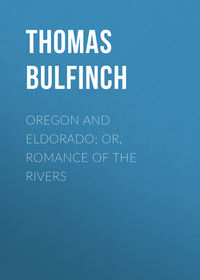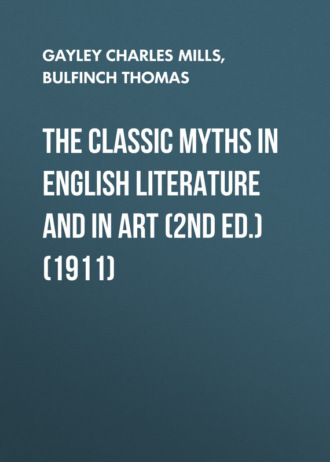 полная версия
полная версияThe Classic Myths in English Literature and in Art (2nd ed.) (1911)
In Sculpture. The Satyr, or so-called Faun, of Praxiteles in the Vatican (text, Fig. 106); Dancing Faun (Lateran, Rome); Dancing Faun, Drunken Faun, Sleeping Faun, and Faun and Bacchus (National Museum, Naples); The Barberini Faun, or Sleeping Satyr (Glyptothek, Munich).
Flora. Painting by Titian (Uffizi, Florence).
55. The first love of Zeus was Metis, daughter of Oceanus and Tethys. She is Prudence or Foreknowledge. She warned Zeus that if she bore him a child, it would be greater than he. Whereupon Zeus swallowed her; and, in time, from his head sprang Athene, "the virgin of the azure eyes, Equal in strength, and as her father wise" (Hesiod, Theog.). On Latona, see 32, 73, and Commentary.
56. For Danaë see 151; for Alemene, 156; for Leda, 194.
57. In the following general table of the Race of Inachus (see p. 488), marriages are indicated in the usual manner (by the sign =, or by parentheses); the more important characters mentioned in this work are printed in heavy-faced type. While numerous less important branches, families, and mythical individuals have been intentionally omitted, it is hoped that this reduction of various relationships, elsewhere explained or tabulated, to a general scheme, may furnish the reader with a clearer conception of the family ties that motivate many of the incidents of mythical adventure, and that must have been commonplaces of information to those who invented and perpetuated these stories. It should be borne in mind that the traditions concerning relationships are by no means consistent, and that consequently the collation of mythical genealogies demands the continual exercise of discretion, and a balancing of probabilities. Notice that from the union of Jupiter and Io (Table D), Hercules is descended in the thirteenth generation.
Inachus is the principal river of Argolis in the Peloponnesus.
Interpretative. Io is explained as the horned moon, in its various changes and wanderings. Argus is the heaven with its myriad stars, some of them shut, some blinking, some always agleam. The wand of Hermes and his music may be the morning breeze, at the coming of which the eyes of heaven close (Cox, 2, 138; Preller 2, 40). The explanation would, however, be just as probable if Mercury (Hermes) were a cloud-driving wind. Pan and the Syrinx: naturally the wind playing through the reeds, if (with Müller and Cox) we take Pan to be the all-purifying, but yet gentle, wind. But see p. 181.
Illustrative. Shelley, To the Moon, "Art thou pale for weariness Of climbing heaven and gazing on the earth, Wandering companionless Among the stars that have a different birth?" Milton's "To behold the wandering moon, Riding near her highest noon, Like one that had been led astray, Through the heaven's wide pathless way" (Il Penseroso). See also for Io, Shelley's Prometheus Bound. Argus: Milton, Paradise Lost, 11, 131; Pope, Dunciad, 2, 374; 4, 637.
In Art. Fig. 47 in the text, from a wall-painting of Herculaneum (Museum, Naples). Correggio's painting, Jupiter and Io; not a pleasant conception.
58. Interpretative. The myth of Callisto and Arcas is of Arcadian origin. If the Arcadians, in very remote times, traced their descent from a she-bear, and if they also, like other races, recognized a bear in a certain constellation, they might naturally mix the fables and combine them later with the legend of the all-powerful Zeus (Lang, 2, 181). According to another account, Callisto was punished for her love of Jupiter by Diana (Artemis). Her name has been identified with the adjective Calliste, 'most fair,' which was certainly applied to Artemis herself. That Artemis was protectress of she-bears is known; also that, in Attica, she was served by girls who imitated, while dancing, the gait of bears. It is quite possible, therefore, that Artemis inherited a more ancient worship of the bear that may have been the totem, or sacred animal, from which the Arcadians traced a mythological descent. Others hold that the word arksha, 'a star,' became confused with the Greek arktos, 'a bear.' So the myth of the son Arcas (the star and the bear) may have arisen (Max Müller). The last star in the tail of the Little Bear is the Polestar, or Cynosure (dog's tail).
Table D. The Race of Inachus and its Branches
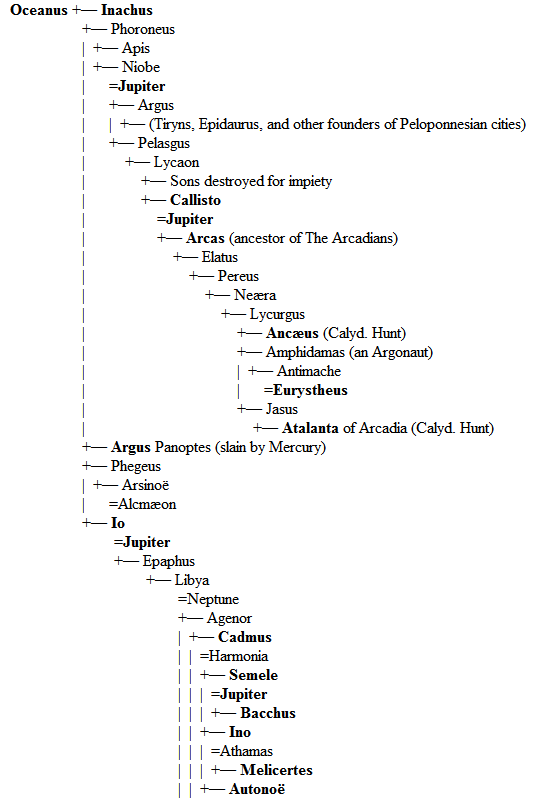
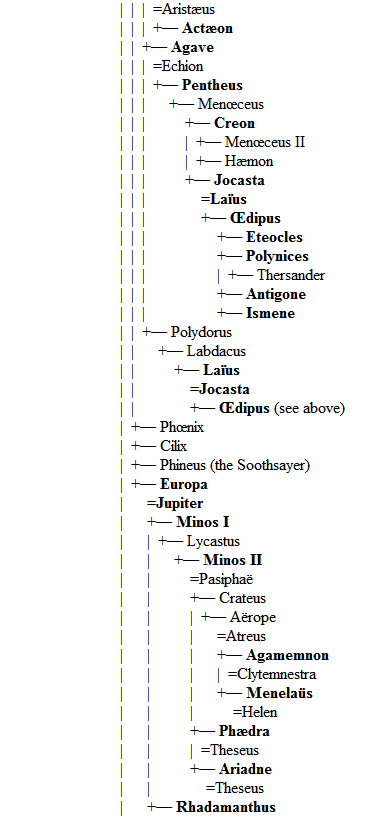
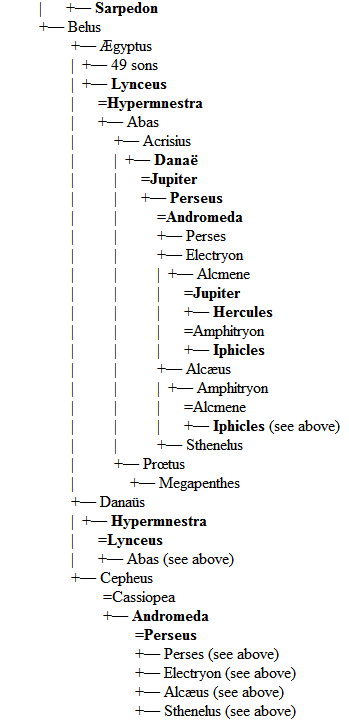
Illustrative. Milton's "Let my lamp, at midnight hour, Be seen in some high lonely tower, Where I may oft outwatch the Bear" (Il Penseroso); and his "Where perhaps some beauty lies The cynosure of neighbouring eyes" (L'Allegro); also his "And thou shalt be our star of Arcady, Or Tyrian Cynosure" (Comus). Note Lowell's "The Bear, that prowled all night about the fold Of the North-star, hath shrunk into his den" (Prometheus). See also the song beginning, "Hear ye, ladies, that despise What the mighty Love had done," in Beaumont and Fletcher's drama, Valentinian, – for Callisto, Leda, and Danaë.
59. The Descendants of Agenor. For further details, see Table D.
Table E
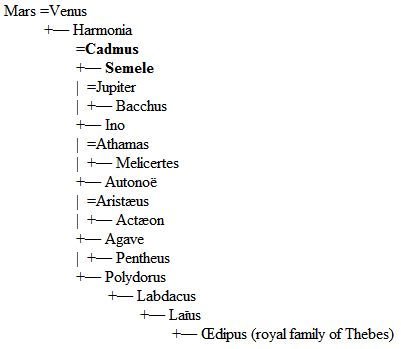
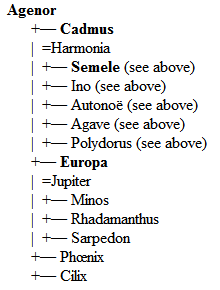
Textual. Moschus lived about the close of the third century B.C. in Syracuse. He was a grammarian and an idyllic poet. He calls himself a pupil of Bion, – whose Lament for Adonis is given in 100. Both Bion and Moschus belong to the School of Theocritus – the Idyllic or Pastoral School of Poetry. Cypris: Venus, by whom the island of Cyprus was beloved. Mygdonian flutes: the ancients had three species or modes of music, depending, respectively, upon the succession of musical intervals which was adopted as the basis of the system. The Lydian measures were shrill and lively; the Dorian deep in tone, grave, and solemn; the Mygdonian, or Phrygian, were supposed by some to have been the same as the Lydian, but more probably they were a combination of Lydian and Dorian. Shaker of the World: Neptune. Crete: where Jupiter had been concealed from his father Cronus, and nourished by the goat Amalthea.
Interpretative. Herodotus says that Europa was a historical princess of Tyre, carried off by Hellenes to Crete. Taurus (the bull) was euhemeristically conceived to be a king of Crete who carried off the Tyrian princess as prize of war. Others said that probably the figurehead of the ship in which Europa was conveyed to Crete was a bull. It is not improbable that the story indicates a settlement of Phœnicians in Crete and the introduction by them of cattle. Modern critics, such as Preller and Welcker, make Europa a goddess of the moon = Diana or Astarte, and translate her name "the dark, or obscured one." But she has undoubtedly a connection with the earth, perhaps as wife of Jupiter (the Heaven). H. D. Müller connects both Io and Europa with the wandering Demeter (or Ceres), and considers Demeter to be a goddess both of the moon and of the earth (Helbig, in Roscher). Cox, after his usual method, finds here the Dawn borne across the heaven by the lord of the pure ether. Europa would then be the broad-spreading flush of dawn, seen first in the purple region of morning (Phœnicia). Her brother Cadmus, who pursues her, would be the sun searching for his lost sister or bride. Very fanciful, but inconclusive. The bull occurs not infrequently in myth as an incarnation of deity.
Illustrative. W. S. Landor, Europa and her Mother; Aubrey De Vere, The Rape of Europa; E. Dowden, Europa; W. W. Story, Europa (a sonnet). See also a graceful picture in Tennyson's Palace of Art.
In Art. Fig. 48, in text, from vase found at Cumæ; the marble group in the Vatican, Europa riding the Bull; painting by Paolo Veronese, The Rape of Europa; Europa, by Claude Lorrain.
60. See Tables D and E.
Interpretative. According to Preller, Semele is a personification of the fertile soil in spring, which brings forth the productive vine. In the irrational part of the myth, Jove takes the child Dionysus (Bacchus), after Semele's death, and sews him up in his thigh for safe-keeping. Preller finds here "the wedlock of heaven and earth, the first day that it thunders in March." Exactly why, might be easy to guess, but hard to demonstrate. The thigh of Jupiter would have to be the cool moist clouds brooding over the youthful vine. The whole explanation is altogether too conjectural. See A. Lang's Myth, Ritual, etc., 2, 221-225, for a more plausible but less poetic theory.
Illustrative. Milton, Paradise Regained, 2, 187; Bowring's translation of Schiller's Semele; E. R. Sill, Semele, of which a part is given in the text.
In Art. Fig. 50, in text.
61. Textual. The son of Ægina and Jove was Æacus (for genealogy, see Table O (1)). Ægina: an island in the Saronic Gulf, between Attica and Argolis. Asopus: the name of two rivers, one in Achaia, one in Bœotia, of which the latter is the more important. The Greek traveler, Pausanias, tells us that Asopus was the discoverer of the river which bears his name. Sisyphus, see 255. This description of the plague is copied by Ovid from the account which Thucydides gives of the plague of Athens. That account, much fuller than is here given, was drawn from life and has been the source from which many subsequent poets and novelists have drawn details of similar scenes. The Myrmidons were, during the Trojan War, the soldiers of Achilles, grandson of this king Æacus.
Interpretative. The name Ægina may imply either the shore on which the waves break (Preller), or the sacred goat (Ægeus) which was the totem of the Ægeus family of Attica. The worship of Athene was introduced into Athens by this family. In sacrifices the goddess was clad in the skin of the sacred goat, but no goat might be sacrificed to her. Probably another example of the survival of a savage ritual (Lang, Myth, Ritual, etc., 1, 280).
Illustrative. Myrmidons:
No, no, said Rhadamant, it were not well,With loving souls to place a martialist;He died in war, and must to martial fields,Where wounded Hector lives in lasting pain,And Achilles' Myrmidons do scour the plain.Kyd, Spanish TragedyOn Sisyphus, read Lewis Morris' poem in The Epic of Hades.
62. Textual. Mænad: the Mænades, from μαίνομαι (mainomai), 'to rage,' were women who danced themselves into a frenzy in the orgies or festivals of Bacchus. Cithæron: a mountain range south of Thebes and between Bœotia and Attica.
Interpretative. Antiope, philologically interpreted, may indicate the moon with face turned full upon us. That Antiope is a personification of some such natural phenomena would also appear from the significance of the names associated with hers in the myth: Nycteus, the night-man; Lycus, the man of light. Amphion and Zethus are thought, in like fashion, to represent manifestations of light; see also Castor and Pollux. Perhaps the method employed by Zethus and Amphion in building Thebes may merely symbolize the advantage of combining mechanical force with well-ordered or harmonious thought.
In Art : The Farnese Bull group (text, opp. p. 74): marble, maybe by Tauriscus and Tralles, in Naples Museum. Fig. 51: a relief in the Palazzo Spada, Rome. Modern painting: Correggio's Antiope.
63. Textual. Phrygia: a province in Asia Minor. For Minerva's protection of the olive, see 65. Tyana is a town in Cappadocia, Asia Minor.
64. Textual. Argos: the capital of Argolis in the Peloponnesus. Of Cydippe, it is told, in Ovid's Heroides and elsewhere, that, when a girl sacrificing in the temple of Diana in Delos, she was seen and loved by a youth, Acontius. He threw before her an apple, on which these words were inscribed, "I swear by the sanctuary of Diana to marry Acontius." The maiden read aloud the words and threw the apple away. But the vow was registered by Diana, who, in spite of many delays, brought about the marriage of Cydippe and her unknown lover. Polyclitus the Elder, of Argos, lived about 431 B.C., and was a contemporary of two other great sculptors, Phidias and Myron. His greatest work was the chryselephantine statue of Hera for her temple between Argos and Mycenæ.
Illustrative. Beside Gosse's Sons of Cydippe, see verses by L. J. Richardson, in The Inlander, Ann Arbor, Vol. 2, p. 2. For the story of Acontius and Cydippe, see William Morris' Earthly Paradise; and Lytton's Cydippe, or The Apples, in The Lost Tales of Miletus.
In Art. The severe design in clay by Teignmouth, of which prints may be obtained, was made to illustrate Gosse's poem.
65-66. Textual. For Cecrops, see 174. He named the city that he founded Cecropia, – a name which afterwards clung to Athens. For an excellent description of ancient weaving, see Catullus, LXIV, 304-323 (The Peleus and Thetis). For translation, see 191. Leda, mother of Castor, Pollux, Helen, and Clytemnestra (see 194 and Commentary). Danaë, mother of Perseus (see 151).
Interpretative. The waves were the coursers of Neptune, – the horses with which he scours the strand. Arachne: a princess of Lydia. It is probable that the myth symbolizes the competition in products of the loom between Attica and Asia Minor and the superior handicraft of the Athenian weavers.
Illustrative. Arachne: Shakespeare, Troilus and Cressida, V, ii; Pope, Dunciad, 4, 590. Poem: Garrick, Upon a Lady's Embroidery.
In Art. Fig. 52, in text: from a vase in St. Petersburg.
68. Textual. Diomede: for his genealogy, see Table K. Taslets: armor worn about the thighs. Cyprian: Venus. Pæan (Pæon, or Paiëon), classed by Homer among the Olympian gods, of whom he is, as his name implies, the "healer." Later, the name was applied to Æsculapius, then to any god who might repair or avert evil of any kind, as, for instance, to Apollo and to Thanatos (Death). See Armstrong's Art of Health, "So Pæan, so the powers of Health command," etc., and "the wise of ancient days Adored one power of physic, melody, and song." Pæans were chants in honor of Apollo, sung to deprecate misfortune in battle or to avert disease. Lower than the sons of Heaven: lower than the Titans, sons of Uranus (Heaven), who were plunged into Tartarus.
69. Textual. Lessing points out in his Laocoön the skill with which Homer, stating the size of the stone hurled by Minerva and the measure of the space covered by Mars, suggests the gigantic proportions of the warring divinities.
70. Textual. Family of Cadmus: see Tables D and E. Castalian Cave of Mount Parnassus, Phocis; here was the famous Delphic oracle of Apollo. Cephissus: a river running through Doris, Phocis, and Bœotia into the Eubœan Gulf; the valley of the Cephissus was noted for its fertility. Panope: a town on the Cephissus. Tyrians: Cadmus and his followers came from Tyre in Phœnicia. The Necklace of Harmonia was a fateful gift. It brought evil to whomsoever it belonged: to all the descendants of Cadmus; to Eriphyle, wife of Amphiaraüs of Argos, to whom Polynices gave it; and to the sons of Eriphyle. It was finally dedicated to Apollo in Delphi. Harmonia's robe possessed the same fatality, 187, 189. Enchelians: a people of Illyria. For the myths of Semele, see 60; of Ino, 144; of Autonoë and her son, Actæon, 95; of Agave and her son, Pentheus, 112; of Polydorus, the Labdacidæ, Œdipus, etc., 182. Eight years: the usual period of penance. Apollo, after slaying the Python, had to clear himself of defilement by a period of purification.
Interpretative. Cadmus and his Tyrians: according to the usual explanation, this myth is based upon an immigration of Phœnicians, who settled Bœotia and gave laws, the rudiments of culture (alphabet, etc.), and industrial arts to the older races of Greece. Many Theban names, such as Melicertes, Cadmus, point to a possible Phœnician origin; cf. Semitic Melkarth, and Kedem, the East. But Preller holds that two mythical personages, a Greek Cadmus and a Phœnician Cadmus, have been confounded; that the Theban Cadmus is merely the representative of the oldest Theban state; that the selection of the spot on which a heifer had lain down was a frequent practice among settlers, superstitious about the site of their new town; that the dragon typifies the cruel and forbidding nature of the uncultivated surroundings; and that the story of the dragon's teeth was manufactured to flatter the warlike spirit of the Thebans, the teeth themselves being spear points.
Harmonia, daughter of the patron deities of Thebes, is the symbol of the peace and domesticity that attend the final establishment of order in the State.
According to the Sun-and-Cloud theory of Cox, Cadmus, the Sun, pursues his sister, Europa, the broad-flushing light of Dawn, who has been carried off on a spotless cloud (the Bull). The Sun, of course, must journey farther west than Crete. The heifer that he is to follow is, therefore, still another cloud (like the cattle of the Sun, – clouds). The dragon of Mars is still a third cloud; and this the Sun dissipates. A storm follows, after which new conflicts arise between the clouds that have sprung up from the moistened earth (the harvest of armed men!). This kind of explanation, indiscriminately indulged, delights the fancy of the inventor and titillates the risibles of the reader.
Illustrative. Milton, Paradise Lost, 9, 506. The serpent that tempted Eve compared with the serpents Cadmus and "Hermione." See Byron, Don Juan, 3, 86, "You have the letters Cadmus gave – Think you he meant them for a slave?"
In Art. Fig. 54, in text: from a vase in the Naples Museum. Fig. 55 is of a vase-painting from Eretria.
71. Textual. Eurynome is represented by some as one of the Titans, the wife of Ophion. Ophion and Eurynome, according to one legend, ruled over heaven before the age of Saturn (Cronus). So Milton, Paradise Lost, 10, 580, "And fabled how the Serpent, whom they called Ophion, with Eurynome (the wide-Encroaching Eve perhaps), had first the rule Of high Olympus, thence by Saturn driven." According to Vulcan's statement (Iliad, 18), Eurynome was daughter of Oceanus and Tethys. She was mother, by Jupiter, of the Graces. Thetis: see 50. Xanthus: the principal river of Lycia in Asia Minor.
72-73. Interpretative. Latona (Leto): according to Homer, one of the deities of Olympus; a daughter of the Titans Cœus and Phœbe, whose names indicate phenomena of radiant light. She belonged, perhaps, to an ancient theogony of Asia Minor. At any rate she held at one time the rank of lawful wife to Zeus. Preller and, after him, Cox take Leto as the dusk or darkness. Cox traces the word to the root of Lethe (the forgetful), but Preller is doubtful. Possibly Leto and Leda, the mother of the bright Castor and Pollux, have something in common. The wanderings of Latona may be the weary journey of the night over the mountain tops, both before and after the Sun (Apollo) is born in Delos (the land of Dawn).
Illustrative. Milton, Arcades, 20, and Sonnet XII, "On the detraction which followed upon my writing certain treatises."
74. Textual. Hyperboreans: those who dwell in the land beyond the North. Pæan, see C. 68. Tityus: an earthborn giant; condemned to the underworld, he lay stretched over nine acres while two vultures devoured his liver.
Interpretative. Python: in many savage myths, a serpent, a frog, or a lizard that drinks up all the waters, and is destroyed by some national hero or god. As Mr. Lang says: "Whether the slaying of the Python was or was not originally an allegory of the defeat of winter by sunlight, it certainly, at a very early period, became mixed up with ancient legal ideas and local traditions. It is almost as necessary for a young god or hero to slay monsters as for a young lady to be presented at court; and we may hesitate to explain all these legends of a useful feat of courage as nature myths" (Myth, Ritual, etc., 2, 196). Compare the feats of Hercules, Jason, Bellerophon, Perseus, St. George and the Dragon, Sigurd, and Jack the Giant Killer. Commentators take Python to be the rigor of winter, or the darkness of night, or a "black storm-cloud which shuts up the waters" (Cox). It is not impossible that the Python was the sacred snake of an older animal worship superseded by that of Apollo. (See also C. 38.)
75. Textual. The Tyrian hue is purple, made from the juice of the murex, or purple shellfish. On the leaves of the hyacinth were inscribed characters like Ai, Ai, the Greek exclamation of woe. It is evidently not our modern hyacinth that is here described, but perhaps some species of iris, or of larkspur, or pansy. The meaning of the name is also uncertain, but the best authorities favor youthful. A festival called the Hyacinthia was celebrated, in commemoration of the myth, over a large part of the Peloponnesus. It lasted three days, probably in the first half of July. It consisted of chants of lamentation and fasting during the first and last days; during the second day, of processions, a horse race, joyous choral songs, dances, feasting, and sacrifice.
Interpretative. Most scholars consider Hyacinthus to be the personification of the blooming vegetation of spring, which withers under the heats of summer. The Hyacinthian festival seems to have celebrated – like the Linus festival and the Eleusinian – the transitory nature of life and the hope of immortality.
Illustrative. Keats, Endymion, "Pitying the sad death Of Hyacinthus, when the cool breath Of Zephyr slew him" (see context); Milton, Lycidas, "Like to that sanguine flower inscribed with woe"; On the Death of a Fair Infant, 4.


